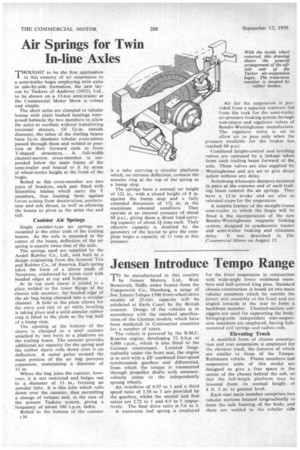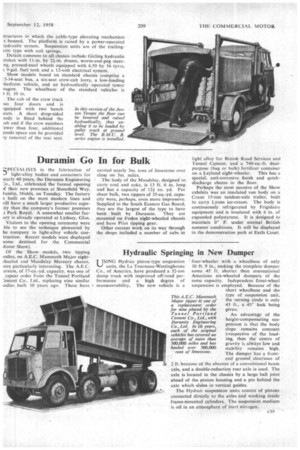Jensen Introduce Tempo Range
Page 72

Page 75

If you've noticed an error in this article please click here to report it so we can fix it.
rbe manufactured in this country by Jensen Motors, Ltd., West Bromwich, Staffs, under licence from the Tempowerk Co., Hamburg, a range of five Jensen-Tempo 1500 front-wheel-drive models of 25-cwt. capacity will be exhibited at Earls Court by the British concern. Design of the vehicles is in accordance with the standard specifications of the German models, which have been marketed in Continental countries for a number of years.
The vehicle is powered by the B.M.C. B-series engine, developing 52 b.h.p. at 4,000 r.p.m., which is also fitted to the German counterpart. Located longitudinally under the front seat, the engine is in unit with a ZF combined four-speed synchromesh gearbox and differential, from which the torque is transmitted through propeller shafts with constantvelocity joints to the independently sprung wheels.
An overdrive of 0.97 to 1 and a third speed ratio of 1.58 to 1 are provided by the gearbox, whilst the second and first ratios are 2.72 to 1 and 4.9 to 1 respectively. The final drive ratio is 5.6 to 1.
A transverse leaf spring is employed for the front suspension in conjunction with wide-angle lower wishbone members and ball-jointed king pins. Standard chassis construction is based on two main tubular members which lie outside the power unit assembly at the front and are angled inwards at the rear to form a backbone member. Channel-section outriggers are used for supporting the body. Swinging-axle independent rear-suspension members are employed, having hubmounted coil springs and radius rods.
Elevating Truck
A modified form of chassis construction and rear suspension is employed for the elevator truck, the features of which are similar to those of the TempoRuthmann vehicle. Frame members and suspension units of this model are designed to give a free space in the centre of the chassis behind the cab, so that the full-length platform may be lowered from its normal height of 4 ft. 3 in. to ground level.
Each rear main member comprises two tubular sections located longitudinally to form the side framing of the body, and these are welded to the tubular side ;tructures in which the cable-type elevating mechanism s housed. The platform is raised by a power-operated tydraulic system. Suspension units are of the trailingirm type with coil springs.
Details common to all chassis include Girling hydraulic rakes with II-in, by 2i-in. drums, worm-and-peg steerng, pressed-steel wheels equipped with 6.50 by 16 tyr4s, 9-gal, fuel tank and a 12-volt electrical system.
Show models based on standard chassis comprise a 3-I4-seat bus, a six-seat crew-cab lorry, a low-loading llatform vehicle, and an hydraulically operated tower wagon. The wheelbase of the standard vehicles is ) ft. 10 in.
The cab of the crew truck as four doors and is :quipped with two bench ;eats. A short drop-sided )ody is fitted behind the :ab and if the crew numbers 'ewer than four, additional mods space can be provided ay removal of the rear seat.
























































































































